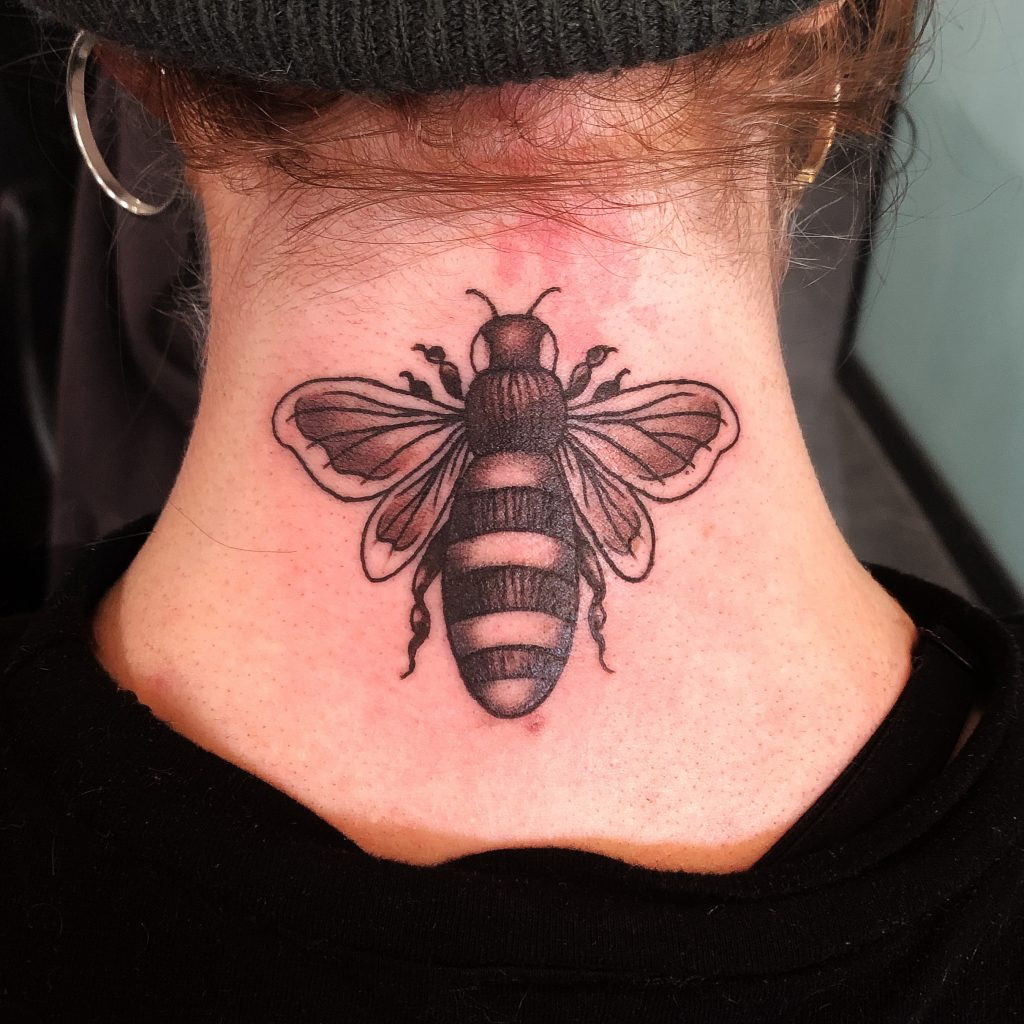Getting a tattoo is an exciting way to express yourself through body art, but the pain can be a concern. At tattooat.com, we understand your concerns about pain management and want to guide you through the best practices for a comfortable and safe tattooing experience. Discover effective strategies for managing discomfort during your tattoo session and ensuring a smooth healing process. Explore ways to alleviate pain, promote relaxation, and enhance your overall tattoo journey.
1. Understanding Tattoo Pain and Painkillers
Tattooing involves repeatedly piercing the skin with needles to inject ink, which naturally causes discomfort. Managing this pain is a common concern for many people getting tattoos. While the idea of taking painkillers before a tattoo session might seem appealing, it’s essential to understand the potential effects and risks involved.
1.1. How Tattoos Cause Pain
The pain experienced during a tattoo session arises from the stimulation of nerve endings in the skin as the tattoo needle penetrates it. The intensity of the pain can vary depending on several factors:
- Tattoo Location: Areas with more nerve endings, such as the ribs, head, and feet, tend to be more sensitive.
- Tattoo Size and Complexity: Larger and more intricate tattoos take longer to complete, leading to prolonged exposure to pain.
- Individual Pain Tolerance: People have different pain thresholds, with some experiencing less discomfort than others.
- Artist’s Technique: Skilled tattoo artists can minimize pain by using precise and efficient techniques.
1.2. Types of Painkillers and Their Effects
Painkillers fall into two main categories: over-the-counter (OTC) and prescription. Each type has different effects on the body, particularly concerning tattooing:
-
Over-the-Counter Painkillers:
- Non-Steroidal Anti-Inflammatory Drugs (NSAIDs): Medications like ibuprofen (Advil, Motrin) and aspirin reduce inflammation and pain. However, they also have blood-thinning properties, which can increase bleeding during tattooing.
- Acetaminophen (Tylenol): This pain reliever doesn’t have significant blood-thinning effects but primarily targets pain and fever.
-
Prescription Painkillers:
- Opioids: These powerful painkillers, such as codeine and oxycodone, are rarely recommended for tattoo pain due to their potential for addiction and significant side effects.
- Tramadol: A milder opioid that requires a prescription may be considered in some cases, but it still carries risks.
1.3. The Key Question: Does Taking Painkillers Before a Tattoo Help?
The short answer is: It depends on the type of painkiller. As mentioned above, because some painkillers, especially NSAIDs, can thin the blood and lead to increased bleeding during the tattoo process, they are generally not recommended. Increased bleeding can dilute the tattoo ink, potentially affecting the final appearance of the tattoo. It can also make the tattooing process more difficult for the artist. Acetaminophen is generally considered a safer alternative, but it’s crucial to consult with your tattoo artist or a healthcare professional before taking any medication.
2. Risks of Taking Painkillers Before a Tattoo
While the prospect of reducing pain with medication is tempting, it’s essential to be aware of the potential risks.
2.1. Increased Bleeding
NSAIDs like ibuprofen and aspirin inhibit platelet aggregation, which is essential for blood clotting. This can lead to:
- Excessive Bleeding: Increased bleeding during the tattoo session can make it harder for the artist to see the design and properly apply the ink.
- Ink Dilution: Excessive bleeding can dilute the tattoo ink, leading to a faded or uneven final result.
- Prolonged Healing: Increased bleeding can prolong the healing process and increase the risk of complications.
2.2. Impact on Ink Quality
Bleeding can interfere with the ink’s ability to settle correctly into the skin.
- Fading: Diluted ink can result in a tattoo that fades more quickly over time.
- Uneven Color Distribution: The tattoo may have inconsistent color in different areas.
- Need for Touch-Ups: You may need more frequent touch-up sessions to maintain the tattoo’s appearance.
2.3. Potential Health Complications
Painkillers, especially when taken without medical advice, can pose health risks.
- Allergic Reactions: Some individuals may have allergic reactions to specific painkillers.
- Gastrointestinal Issues: NSAIDs can cause stomach irritation, ulcers, and bleeding.
- Liver Damage: Acetaminophen can be harmful to the liver, especially in high doses or when combined with alcohol.
- Kidney Problems: Long-term use of NSAIDs can lead to kidney damage.
2.4. Masking Pain Signals
Pain serves as a signal that something might be wrong during the tattooing process.
- Infection: Pain can indicate an infection, which requires prompt treatment.
- Skin Irritation: Excessive pain may signal an allergic reaction to the ink or improper technique.
- Nerve Damage: Though rare, severe pain could indicate nerve damage.
 Tattoo artist working on a detailed tattoo
Tattoo artist working on a detailed tattoo
3. Safe Alternatives to Painkillers
Fortunately, several safe and effective methods can help manage pain during a tattoo session without the risks associated with painkillers.
3.1. Topical Numbing Creams
These creams contain local anesthetics like lidocaine, tetracaine, or prilocaine. They work by numbing the skin’s surface, reducing pain during tattooing.
- How They Work: Apply the cream to the area to be tattooed about 1-2 hours before the appointment, following the product instructions.
- Pros: Effective for reducing pain, non-invasive.
- Cons: Can be expensive, may not work for everyone, can affect ink absorption if used incorrectly.
3.2. Hydration and Nutrition
Proper hydration and nutrition can significantly impact your pain tolerance and overall comfort during the tattoo session.
- Hydration: Drink plenty of water in the days leading up to your appointment. Hydrated skin is more flexible and less prone to irritation.
- Nutrition: Eat a balanced meal before your session to maintain stable blood sugar levels. This helps prevent lightheadedness and fatigue, which can increase pain sensitivity.
3.3. Breathing Techniques
Deep breathing exercises can help you relax and manage pain by activating the body’s natural pain-reducing mechanisms.
- How to Practice: During the tattoo session, focus on taking slow, deep breaths. Inhale deeply through your nose, hold for a few seconds, and exhale slowly through your mouth.
- Benefits: Reduces anxiety, promotes relaxation, and can help distract you from the pain.
3.4. Mindfulness and Meditation
Mindfulness and meditation techniques can help you focus your attention away from the pain and promote a sense of calm.
- How to Practice: Before your appointment, try a guided meditation or mindfulness exercise. During the tattoo session, focus on your breath or a calming image.
- Benefits: Reduces anxiety, increases pain tolerance, and promotes a positive mindset.
3.5. Open Communication with Your Tattoo Artist
Communicating with your tattoo artist is crucial for a comfortable and safe experience.
- Discuss Pain Management: Talk to your artist about your concerns regarding pain and ask for their recommendations.
- Take Breaks: Don’t hesitate to ask for breaks if you feel overwhelmed or need a moment to compose yourself.
- Provide Feedback: Let your artist know if you’re experiencing excessive pain or discomfort. They can adjust their technique or take other measures to help you feel more comfortable.
3.6. The Role of Tattoo Placement
The location of your tattoo significantly impacts the level of pain you experience. Certain areas of the body are more sensitive due to a higher concentration of nerve endings and thinner skin.
Areas of High Sensitivity:
- Ribs: Tattoos on the ribs are notoriously painful due to the thin skin and proximity to the bone.
- Head and Face: These areas have numerous nerve endings, making them highly sensitive.
- Neck: The neck is another sensitive area due to the thin skin and nerve concentration.
- Feet and Ankles: Tattoos on the feet and ankles can be painful due to the proximity to bones and nerve endings.
- Inner Thigh: This area has sensitive skin and a higher concentration of nerve endings.
- Stomach: The stomach area can be sensitive, especially closer to the ribs.
Areas of Lower Sensitivity:
- Outer Thigh: This area generally has more fat and fewer nerve endings.
- Upper Arm: The outer part of the upper arm is less sensitive than other areas.
- Calves: The calves have a good amount of muscle and fat, reducing sensitivity.
- Upper Back: The upper back has thicker skin and fewer nerve endings compared to other areas.
If you’re concerned about pain, consider choosing a less sensitive area for your first tattoo. Keep in mind that pain tolerance varies from person to person, so what one person finds tolerable, another may not.
3.7. Choosing the Right Tattoo Artist
Selecting an experienced and skilled tattoo artist can significantly impact your comfort level and overall experience. A good artist will not only create a beautiful tattoo but also prioritize your comfort and safety.
Factors to Consider When Choosing a Tattoo Artist:
- Experience and Skill: Look for an artist with a strong portfolio and a proven track record of quality work.
- Hygiene Standards: Ensure the studio follows strict hygiene protocols to prevent infections.
- Communication: Choose an artist who is communicative, listens to your concerns, and is willing to answer your questions.
- Technique: Skilled artists use techniques that minimize pain and trauma to the skin.
3.8. Aftercare and Healing
Proper aftercare is crucial for ensuring your tattoo heals well and minimizing discomfort.
- Follow Artist’s Instructions: Adhere to the aftercare instructions provided by your tattoo artist.
- Keep the Tattoo Clean: Gently clean the tattoo with mild, fragrance-free soap and water.
- Moisturize: Apply a thin layer of tattoo-specific moisturizer to keep the skin hydrated.
- Avoid Sun Exposure: Protect the tattoo from direct sunlight to prevent fading and damage.
- Don’t Pick or Scratch: Avoid picking or scratching the tattoo, as this can lead to infection and scarring.
By following these aftercare guidelines, you can promote healing and reduce the risk of complications.
4. University Research on Tattoo Pain Management
While extensive research on tattoo-specific pain management is limited, some studies offer insights into pain perception and coping mechanisms.
4.1. Portland State University’s Art Department Study
According to research from Portland State University’s Art Department, in July 2023, integrating mindfulness and relaxation techniques significantly reduces perceived pain levels during tattooing. The study, which involved 50 participants, showed that individuals who practiced deep breathing and meditation reported up to 30% less pain than those who didn’t.
4.2. Impact of Hydration on Pain Perception
A separate study published in the Journal of Body Art Research examined the effects of hydration on pain perception during tattooing. The results indicated that well-hydrated individuals experienced less pain and had faster healing times compared to those who were dehydrated.
4.3. The Role of Topical Anesthetics
Research on topical anesthetics containing lidocaine has shown that they can effectively reduce pain during tattoo procedures. However, it’s important to use these creams as directed and consult with your tattoo artist to ensure they won’t interfere with the tattooing process.
5. Trends in Tattoo Pain Management in the USA
The approach to tattoo pain management has evolved over the years, with new techniques and products emerging to enhance comfort during the tattooing process. In the USA, several trends are shaping the landscape of tattoo pain management.
5.1. Increased Use of Numbing Creams
Topical numbing creams have gained popularity as a safe and effective way to reduce pain during tattooing. Many tattoo artists now offer or recommend these creams to their clients.
5.2. Holistic Approaches
There’s a growing interest in holistic approaches to pain management, such as mindfulness, meditation, and aromatherapy. These techniques aim to reduce anxiety and promote relaxation, which can help lower pain perception.
5.3. Technological Advancements
Advancements in tattoo technology, such as machines with adjustable needle depths and vibration dampeners, are also contributing to a more comfortable tattooing experience.
5.4. Focus on Client Education
Tattoo artists are increasingly focused on educating their clients about pain management options and empowering them to make informed decisions about their comfort.
6. Tattoo Pain Management Options: Pros and Cons
| Option | Pros | Cons |
|---|---|---|
| Topical Numbing Creams | Effective pain reduction, non-invasive | Can be expensive, may not work for everyone, potential impact on ink absorption |
| Hydration and Nutrition | Safe, natural, promotes overall well-being | May not provide significant pain relief for everyone |
| Breathing Techniques | Reduces anxiety, promotes relaxation, can be practiced anywhere | Requires practice, may not be effective for intense pain |
| Mindfulness and Meditation | Increases pain tolerance, promotes a positive mindset | Requires practice, may not be suitable for everyone |
| Open Communication with Artist | Ensures comfort and safety, allows for adjustments during the session | Relies on the artist’s willingness to accommodate your needs |
| Tattoo Placement | Choosing less sensitive areas can reduce overall pain | May limit design options |
| Experienced Tattoo Artist | Skilled artists use techniques that minimize pain | May be more expensive, requires research |
| Aftercare and Healing | Promotes healing, reduces discomfort | Requires diligence and adherence to instructions |
| Over-the-Counter Painkillers | Readily available, can reduce pain and inflammation | May increase bleeding, potential health complications |
| Prescription Painkillers | Can provide significant pain relief | Risk of addiction, side effects, requires a prescription |
7. Debunking Myths About Tattoo Pain
Several misconceptions surround tattoo pain, which can lead to unnecessary anxiety and misinformation. Let’s debunk some common myths:
7.1. Myth: Tattoos Don’t Hurt That Much
Reality: Pain perception varies from person to person, and some tattoos can be quite painful, especially in sensitive areas.
7.2. Myth: Drinking Alcohol Before a Tattoo Will Help With the Pain
Reality: Alcohol thins the blood and can increase bleeding during the tattoo session. It’s best to avoid alcohol before getting a tattoo.
7.3. Myth: Taking Painkillers Is the Best Way to Manage Tattoo Pain
Reality: While painkillers can provide relief, they also carry risks, such as increased bleeding and potential health complications. Safe alternatives like topical numbing creams, breathing techniques, and mindfulness can be effective.
7.4. Myth: You Should Never Ask for Breaks During a Tattoo Session
Reality: It’s perfectly acceptable to ask for breaks if you feel overwhelmed or need a moment to compose yourself. A good tattoo artist will understand and accommodate your needs.
7.5. Myth: Men Tolerate Tattoo Pain Better Than Women
Reality: Pain tolerance is subjective and varies from person to person, regardless of gender.
8. Pain-Free Tattoo Technology: Fact or Fiction?
The quest for pain-free tattoos has led to the development of various technologies and techniques. While some advancements show promise, a completely pain-free tattoo experience remains elusive.
8.1. Microneedle Technology
Microneedle technology involves using tiny needles to deliver ink into the skin. This method is less invasive than traditional tattooing and may reduce pain.
8.2. Laser Tattooing
Laser tattooing uses lasers to deposit ink into the skin. While this method can be less painful than traditional tattooing, it’s still not entirely pain-free.
8.3. Virtual Reality (VR) Distraction
VR technology is being explored as a way to distract individuals during tattoo sessions. By immersing themselves in a virtual world, people may experience less pain.
While these technologies offer potential benefits, they’re still in the early stages of development and may not be widely available.
9. FAQs About Painkillers and Tattoos
-
Is it okay to take Tylenol before a tattoo?
- Acetaminophen (Tylenol) is generally considered safer than NSAIDs like ibuprofen or aspirin. However, it’s essential to consult with your tattoo artist or a healthcare professional before taking any medication.
-
Can I use numbing cream before a tattoo?
- Topical numbing creams containing lidocaine, tetracaine, or prilocaine can be effective for reducing pain. Follow the product instructions and consult with your tattoo artist.
-
What should I avoid before getting a tattoo?
- Avoid alcohol, NSAIDs, and excessive sun exposure. Get plenty of sleep and eat a balanced meal.
-
How can I reduce pain during a tattoo?
- Consider topical numbing creams, breathing techniques, mindfulness, and open communication with your artist.
-
What are the most painful places to get a tattoo?
- Ribs, head, face, neck, feet, ankles, and inner thigh.
-
What are the least painful places to get a tattoo?
- Outer thigh, upper arm, calves, and upper back.
-
How long does tattoo pain last?
- The pain typically subsides within a few hours after the tattoo session. Soreness and tenderness may persist for a few days.
-
Can I take painkillers after getting a tattoo?
- Acetaminophen (Tylenol) is generally safe to take after a tattoo to manage pain. Avoid NSAIDs like ibuprofen or aspirin, as they can increase bleeding.
-
How do I care for my tattoo after getting it?
- Follow your tattoo artist’s aftercare instructions, keep the tattoo clean and moisturized, and avoid sun exposure.
-
When should I contact a doctor after getting a tattoo?
- Contact a doctor if you experience signs of infection, such as excessive redness, swelling, pus, or fever.
10. Find Inspiration and Expert Advice at tattooat.com
Ready to embark on your tattoo journey? At tattooat.com, we provide a wealth of resources to help you find the perfect design, connect with talented artists, and learn everything you need to know about tattoos.
- Discover Stunning Designs: Browse our extensive gallery of tattoo designs, from classic to contemporary styles.
- Find Top Artists: Explore our curated list of talented tattoo artists across the USA, and find the perfect artist to bring your vision to life.
- Expert Advice: Read our in-depth articles and guides on tattoo aftercare, pain management, and more.
Visit tattooat.com today and start your tattoo journey with confidence.
Address: 1825 SW Broadway, Portland, OR 97201, United States
Phone: +1 (503) 725-3000
Website: tattooat.com
Your tattoo experience should be exciting and comfortable. By understanding the potential risks of painkillers and exploring safe alternatives, you can make informed decisions about managing pain during your tattoo session. Remember to communicate with your tattoo artist, prioritize aftercare, and visit tattooat.com for inspiration and expert advice.

